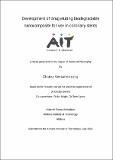| dc.contributor.advisor | Devine, Declan | |
| dc.contributor.advisor | Major, Ian | |
| dc.contributor.advisor | Lyons, Sean | |
| dc.contributor.author | Venkatesh, Chaitra | |
| dc.date.accessioned | 2022-07-07T09:30:03Z | |
| dc.date.available | 2022-07-07T09:30:03Z | |
| dc.date.copyright | 2021 | |
| dc.date.issued | 2021-07 | |
| dc.identifier.citation | Venkatesh, C. (2021). Development of drug eluting biodegradable nanocomposite for use in coronary stents. Thesis (Doctor of Philosophy - PhD). Athlone Institute of Technology. | en_US |
| dc.identifier.uri | http://research.thea.ie/handle/20.500.12065/4023 | |
| dc.description.abstract | Coronary stents are the scaffolds placed inside the blocked arteries, which aids the restoration of the passage of blood to the heart. Coronary stenting has become a standard medical procedure to treat coronary heart disease (blockage or narrowing of the arteries), which is the no. 1 cause of death in the western world. Stents have been developed from the bare metallic stents to drug-eluting stents and then bioresorbable stents (BRS) to prevent various complications and improve their clinical efficacy. As the stent is indeed a foreign object within the vessel, fully biodegradable drug-eluting stents are currently used which will degrade after the required period of support. However, next-generation polymeric BRS still faces many challenges such as stent material (polymer type), mechanical support, and manufacturing process, strut thickness, stent design, under-expansion of the stents, and degradation rate.
To address these challenges, this study was designed to develop an innovative biodegradable polymer nanocomposite by using polylactic acid (PLA) as the polymer matrix reinforced with non-toxic nanoclay, halloysite nanotubes (HNT) and blended with poly e-caprolactone (PCL) to decrease brittleness, using an extrusion process. These materials were selected as they are widely used in the biomedical field due to their biodegradability, and high mechanical properties. The developed nanocomposite was characterized for mechanical, physiochemical, thermal, drug loading, drug release, and degradation properties to address the basic requirements of the stent material.
Primarily, the effect of screw speed during extrusion was examined to ensure homogenous dispersion of the HNT in the PLA matrix. It was found that an increase in screw speeds resulted in a significant increase in strength, and thermal properties by better dispersion of the nanoclay in the polymer matrix. The high strength PLA/HNT nanocomposite was further examined for drug delivery system which displayed sustained drug release. The PLA/HNT composite was fabricated into model stents by 3D printing which did not have the required flexibility for expansion during placement. Hence the composite was further blended with PCL to enhance its flexibility. The developed PLA/PCL/HNT nanocomposite presented improved toughness, strength and flexibility. Further, the degradation of drug-loaded PLA/HNT composite and PLA/PCL/HNT composites was studied for 8 months which indicated faster degradation of PLA/HNT composite loaded with an acidic drug (Aspirin) with no significant weight reduction of the PLA/PCL/HNT nanocomposite.
Results from this study indicate that the use of nanocomposite blends of materials may be suitable for the production of stents via 3D printing. Nevertheless, much work is needed prior to their use in areas such as coronary stents, but they may be suitable for other non-critical stents such as urinary stents, which may warrant further investigation. | en_US |
| dc.format | PDF | en_US |
| dc.language.iso | eng | en_US |
| dc.publisher | Athlone Institute of Technology | en_US |
| dc.rights | Attribution-Non-Commercial-Share-Alike-4.0 International | * |
| dc.rights.uri | http://creativecommons.org/licenses/by-nc-sa/4.0/ | * |
| dc.subject | Biodegradable stents | en_US |
| dc.subject | Drug eluting | en_US |
| dc.subject | Coronary stents | en_US |
| dc.title | Development of drug eluting biodegradable nanocomposite for use in coronary stents | en_US |
| dc.type | info:eu-repo/semantics/doctoralThesis | en_US |
| dc.contributor.affiliation | Athlone Institute of Technology | en_US |
| dc.description.peerreview | yes | en_US |
| dc.identifier.orcid | https://orcid.org/ 0000-0003-4105-6273 | en_US |
| dc.rights.accessrights | info:eu-repo/semantics/openAccess | en_US |
| dc.subject.department | Materials Research Institute AIT | en_US |


